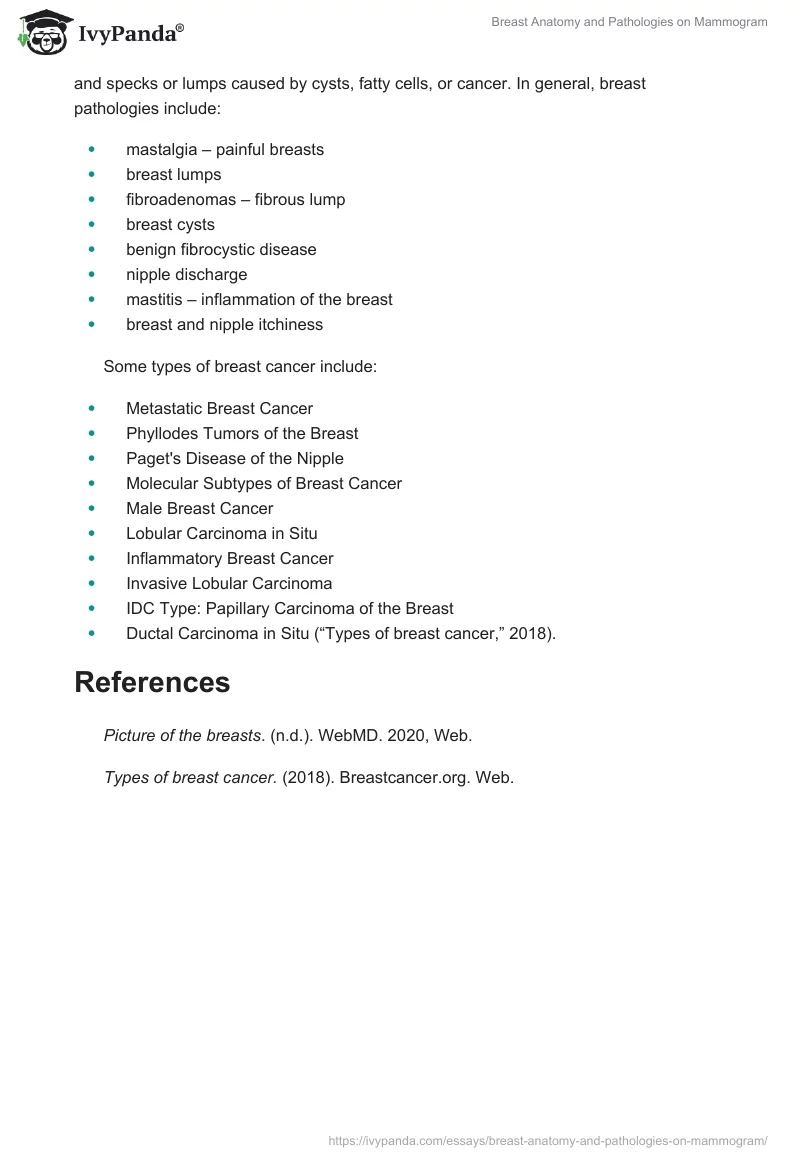Introduction
Women’s breasts may not seem a rather essential part of their bodies. However, they indeed are because they let mothers feed their infants, and for many of them, these moments are unique and most valuable. Unfortunately, just like for any other body’s tissue, there are some dangerous conditions for breasts when special treatment and severe measures are required. The purpose of this paper is to discuss the anatomy of breasts and some common pathologies that may arise when a doctor is performing a mammogram.
Breast Anatomy
The breast is the special tissue that covers the pectoral (chest) muscles. It is made of fatty tissue and another particular tissue (glandular) that has the purpose of producing milk (“Picture of the breasts,” n.d.). Their size depends on the amount of fat, that is why if a woman loses weight, her breasts typically also become smaller. There are lymph nodes, lymph vessels, and blood vessels in the breast (“Picture of the breasts,” n.d.). Its milk-producing part is organized in about twenty sections – lobes, and each of them has lobules – smaller structures where milk is produced. In addition, there is a network of ducts that are tiny tubes through which milk travels.
Breast Pathologies Arising while Performing a Mammogram
Screening mammography is a unique tool used to look for unsuspected breast diseases when there are no evident symptoms. There are some malignant breast pathologies a mammogram can reveal, and most of them are at an early and potentially curable stage (“Picture of the breasts,” n.d.). Thus, screening mammography can see a breast lump before the client can feel it; micro-calcifications (tiny clusters of calcium); and specks or lumps caused by cysts, fatty cells, or cancer. In general, breast pathologies include:
- mastalgia – painful breasts
- breast lumps
- fibroadenomas – fibrous lump
- breast cysts
- benign fibrocystic disease
- nipple discharge
- mastitis – inflammation of the breast
- breast and nipple itchiness
Some types of breast cancer include:
- Metastatic Breast Cancer
- Phyllodes Tumors of the Breast
- Paget’s Disease of the Nipple
- Molecular Subtypes of Breast Cancer
- Male Breast Cancer
- Lobular Carcinoma in Situ
- Inflammatory Breast Cancer
- Invasive Lobular Carcinoma
- IDC Type: Papillary Carcinoma of the Breast
- Ductal Carcinoma in Situ (“Types of breast cancer,” 2018).
References
Picture of the breasts. (n.d.). WebMD. 2020, Web.
Types of breast cancer. (2018). Breastcancer.org. Web.


